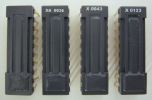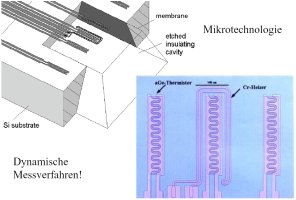Thermal fingerprint sensing
Capture thermique d'empreintes digitales
Thermal fingerprint sensors are taking advantage of the large physical parameter differences between the skin and the air, namely thermal resistivity and thermal capacitance. Like other types of sensors, thermal sensing can be
- passive: this is the temperature difference between the sensor and the skin which produces the heat exchange. static acquisition is a problem as the thermal equilibrium is quickly reached (less than one second).
- active: injecting some heat in the pixel produces a temperature change. If it is the skin (ridge), the heat is pumped and the final temperature is lower than in the air (valley) situation.

The first commercial thermal fingerprint sensor was the FingerChip from Atmel (formerly Thomson-CSF), using PVDF-TrFE (a pyro-electric material able to convert changes of temperature into charges) as sensing layer over a silicon chip. This technology was coming from an uncooled IR camera. It was also the first swipe sensor in 1997: swiping enabled to use a passive sensor.
Other thermal fingerprint sensors are based on microthermistances, with or without heating, with or without a cavity (bolometers) to increase the thermal isolation so the sensitivity.
Products
Thomson-CSF > 2000 > Atmel
- Atmel FingerChip , the best sensor ;-)
- sweep thermal sensing



Next Biometrics
- (2013 Dec) Next Biometrics unveils a new active thermal sensor, composed of an area sensor (LTPS -Low Temperature Poly Silicon- TFT -Thin Film Transistors- and Devices) on glass + a silicon companion chip to drive and read the sensor.
Reseach & Development
Hunno Technologies
- Hunno Technologies [www.hunno.com] & Hyung-Kew Lee (Korea, KAIST) have studied a thermal fingerprint sensor in 1999, probably using bolometers.
INO Institut National d'Optique
- (1998) INO (Institut National d'Optique / Canada) has used bolometers to make a 160x120 pixel fingerprint sensor (US patent 6,633,656). Bolometric FPA for fingerprint recording
Papers :
- Francis Picard et al. "Nonimaging applications for microbolometer arrays," Proc. SPIE 4369, Infrared Technology and Applications XXVII, (10 October 2001);
- Le Noc et al. (2003). "Fingerprint recording with bolometric detectors." Proceedings of SPIE - The International Society for Optical Engineering. 5071. doi: 10.1117/12.487886.
Nagoya University, then Wakayama University
- Nagoya University
has studied a thermal sensor based on MEMS, using a resistor to heat a sensor above a cavity.
L'université de Nagoya a étudié un capteur thermique basé sur des éléments micro-usinés, utilisant une résistance pour chauffer un capteur situé au-dessus d'une cavité. - (2008) Hirobumi Han from the Wakayama university proposes a thermal sensor using micro-heaters on a polyimide substrate. Characteristics of thermal-type fingerprint sensor.
- (2016 Apr) Survey of Biometric Authentication and Proposal of and Proposal of New Sensing Mechanism
/ Hirofumi Miki, Shigeki Tsuchitani (Department of Systems Engineering, Wakayama University).
New? seems to be active sensing using polyimide, like the previous paper.
Papers:
- Ji-Song Han et al. (1999) Thermal analysis of fingerprint sensor having a microheater array Proceedings of MHS '99 Nagoya, 1999, pp. 199-205. doi: 10.1109/MHS.1999.820006
- Han Ji-song et al. "Fabrication of thermal-isolation structure for microheater elements applicable to fingerprint sensors" Sensors and Actuators A: Physical, Volume 100, Issue 1, 2002, Pages 114-122, ISSN 0924-4247
- Han Ji-Song et al. (2003) "Thermal-type micro sensor array on PI film substrate having wet-etched through-holes for interconnection," TRANSDUCERS 2003, pp. 1614-1617 vol.2. doi: 10.1109/SENSOR.2003.1217090
- Han Ji-song et al. (2004). Thermal characterization of micro heater arrays on a polyimide film substrate for fingerprint sensing applications Journal of Micromechanics and Microengineering. 15. 282. 10.1088/0960 - 1317/15/2/006.
- Hiro Han, Yasuhiro Koshimoto, (2008) Characteristics of thermal-type fingerprint sensor, Proc. SPIE 6944, Biometric Technology for Human Identification V, 69440P doi: 10.1117/12.777024
- H. Miki et al. "Survey of Biometric Authentication and Proposal of New Sensing Mechanism." (IJEAS) ISSN: 2394-3661, Volume-3, Issue-4, April 2016
- H. Miki et al. "Structural design points in arrayed micro thermal sensors (I) ~silicon-based approach~" IJETR ISSN: 2321-0869 (O) 2454-4698 (P), Volume-7, Issue-2, February 2017
- H. Miki et al. "Structural design points in arrayed micro thermal sensors (II) ~ Experimental verification~" IJETR ISSN: 2321-0869 (O) 2454-4698 (P), Volume-7, Issue-3, March 2017
- H. Miki et al. "Structural design points in arrayed micro thermal sensors (III) ~ Polymer-based approach~" IJETR ISSN: 2321-0869 (O) 2454-4698 (P), Volume-7, Issue-3, March 2017
IMTEK

- (2005) IMTEK & Schippers propose a thermal fingerprint sensor based on a similar technique than Nagoya Univ., adapted for a smart card.
Papers:
- P. Schippers et al. (2005) "Thermal flexible foil-fingerprint sensor," Digest of Technical Papers. TRANSDUCERS '05, pp. 579-580 Vol. 1. doi: 10.1109/SENSOR.2005.1496483
PYCSEL project
- (2017 Jan) The Pycsel project is devoted
to develop a new fingerprint sensor.
Innovative active thermal sensor, using PVDF-based pyroelectric material, combined with an IGZO TFT matrix foil, capable of high resolution fingerprint capture. - (2019) The Identifying fingerprints by a PYCSEL sensor (CEA website)
- (2019 Mar) The PYCSEL technology was demonstrated at LOPEC 2019 and won the OE-A best Publicly-Funded Project Demonstrator Award. [>> more info <<]
- (August 2019): (press release) PYCSEL, a new thermal fingerprint sensor, winner of the best Publicly Funded Project Demonstrator Award in the OE-Acompetition, will participate in the EAB conference.
- IEDM 2019 / 65th International Electron Devices Meeting / 10-DEC-2019 / San Francisco
Sensors, MEMS, and Bioelectronics 4:25 PM 26.5 A Large-area Curved Pyroelectric Fingerprint Sensor - SID, Book 1: Session 14: Image Sensors : 14.1: Flexible Large-Area Multi-Fingerprint Sensors Based on Thermal Mass Detection / Florian De Roose, Jean-François Mainguet et al. (first publication 25 September 2020).